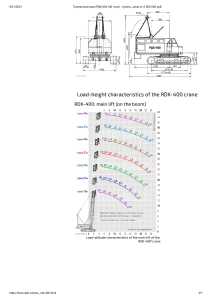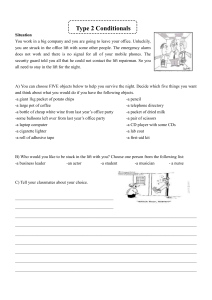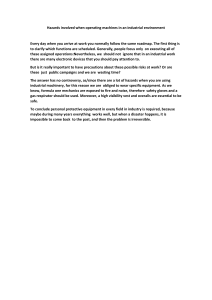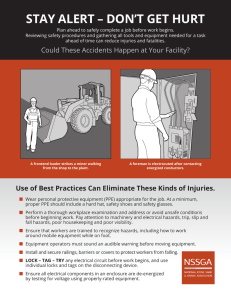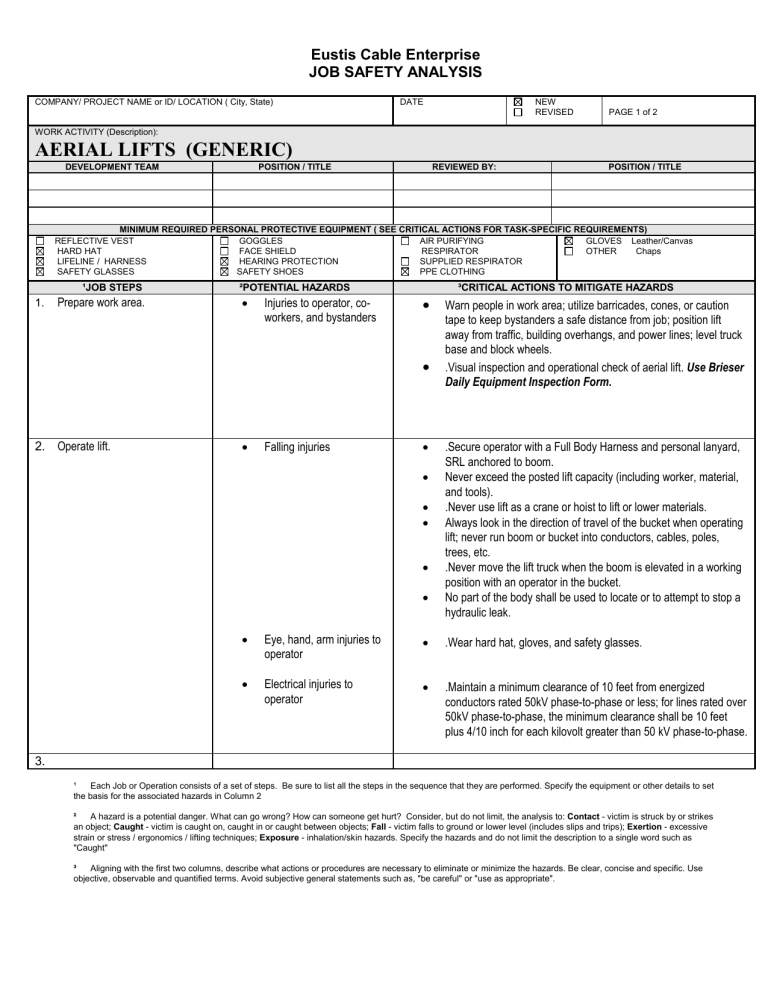
Eustis Cable Enterprise JOB SAFETY ANALYSIS COMPANY/ PROJECT NAME or ID/ LOCATION ( City, State) DATE NEW REVISED PAGE 1 of 2 WORK ACTIVITY (Description): AERIAL LIFTS (GENERIC) DEVELOPMENT TEAM POSITION / TITLE REVIEWED BY: POSITION / TITLE MINIMUM REQUIRED PERSONAL PROTECTIVE EQUIPMENT ( SEE CRITICAL ACTIONS FOR TASK-SPECIFIC REQUIREMENTS) REFLECTIVE VEST GOGGLES AIR PURIFYING GLOVES Leather/Canvas HARD HAT FACE SHIELD RESPIRATOR OTHER Chaps LIFELINE / HARNESS HEARING PROTECTION SUPPLIED RESPIRATOR SAFETY GLASSES SAFETY SHOES PPE CLOTHING ¹JOB STEPS 1. Prepare work area. ²POTENTIAL HAZARDS Injuries to operator, coworkers, and bystanders ³CRITICAL ACTIONS TO MITIGATE HAZARDS 2. Operate lift. Falling injuries Warn people in work area; utilize barricades, cones, or caution tape to keep bystanders a safe distance from job; position lift away from traffic, building overhangs, and power lines; level truck base and block wheels. .Visual inspection and operational check of aerial lift. Use Brieser Daily Equipment Inspection Form. .Secure operator with a Full Body Harness and personal lanyard, SRL anchored to boom. Never exceed the posted lift capacity (including worker, material, and tools). .Never use lift as a crane or hoist to lift or lower materials. Always look in the direction of travel of the bucket when operating lift; never run boom or bucket into conductors, cables, poles, trees, etc. .Never move the lift truck when the boom is elevated in a working position with an operator in the bucket. No part of the body shall be used to locate or to attempt to stop a hydraulic leak. Eye, hand, arm injuries to operator .Wear hard hat, gloves, and safety glasses. Electrical injuries to operator .Maintain a minimum clearance of 10 feet from energized conductors rated 50kV phase-to-phase or less; for lines rated over 50kV phase-to-phase, the minimum clearance shall be 10 feet plus 4/10 inch for each kilovolt greater than 50 kV phase-to-phase. 3. ¹ Each Job or Operation consists of a set of steps. Be sure to list all the steps in the sequence that they are performed. Specify the equipment or other details to set the basis for the associated hazards in Column 2 ² A hazard is a potential danger. What can go wrong? How can someone get hurt? Consider, but do not limit, the analysis to: Contact - victim is struck by or strikes an object; Caught - victim is caught on, caught in or caught between objects; Fall - victim falls to ground or lower level (includes slips and trips); Exertion - excessive strain or stress / ergonomics / lifting techniques; Exposure - inhalation/skin hazards. Specify the hazards and do not limit the description to a single word such as "Caught" ³ Aligning with the first two columns, describe what actions or procedures are necessary to eliminate or minimize the hazards. Be clear, concise and specific. Use objective, observable and quantified terms. Avoid subjective general statements such as, "be careful" or "use as appropriate".

